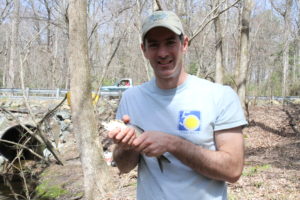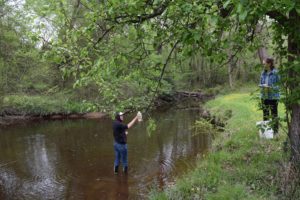Article contributed by the University of Maryland Center for Environmental Science
Using environmental DNA (eDNA) to track the presence of fish in waterways is emerging as a powerful tool to detect and understand the abundance of species in aquatic environments. However, relatively few studies have compared the performance of this emerging technology to traditional catch or survey approaches in the field.
Researchers from the University of Maryland Center for Environmental Science and Smithsonian Environmental Research Center field tested using eDNA—tracking the presence of fish by identifying DNA that has been left behind in the water—to detect river herring in tributaries of Maryland’s Chesapeake Bay. They found that tracking and quantifying herring DNA from the environment corresponded well to more traditional field methods and has great potential to assist future monitoring efforts of river herring abundance and habitat use.
“Sampling a single river, you need a net, crew, permits, it can be expensive,” said study author Louis Plough of the University of Maryland Center for Environmental Science. “The eDNA approach is an alternative where you just take water and you get an idea of the abundance of fish.”
Accurate information on how many fish are in a river system and where they travel is essential to understanding their ecology and how to manage the fishery in increasingly human-impacted environments. Environmental DNA (eDNA) sampling has recently emerged as a powerful, non-invasive alternative to capture-based techniques to detect the presence of a species in their environment.
“You can scoop up water and know what’s been there,” said Plough. “It captures a snapshot of the DNA that has been around in the past couple of weeks.”

SERC ecologist Matt Ogburn catches an Alewife in a tributary of the Nanticoke River. (Credit: Midge Kramer/SERC)
The researchers developed a genetic probe that targeted and identified the DNA of two particular fish species, alewife and blueback herring, collectively known as river herring, in the waterways. As they swim, the fish slough off cells and waste that contain DNA.
“The eDNA method is especially powerful because it can identify whether alewife, blueback herring, or both species are present at each site,” said study co-author Matt Ogburn of the Smithsonian Environmental Research Center. “When we use some traditional methods like collecting fish eggs or larvae, we often aren’t able to tell which river herring species they belong to, and they might even be from other local species like hickory shad.”
River herring, the common name for alewife and blueback herring, were once common in Maryland’s rivers, where they came to spawn every spring. One of the oldest fisheries in North America, they play important roles in coastal food webs—striped bass, bald eagles and osprey like to snack on them—yet the species has declined sharply since the 1970s due to loss of spawning habitat, overfishing, and degradation of water quality.
“These species live in saltwater and spawn in freshwater every spring. They’ve been hit hard by overfishing and habitat loss, including dams that blocked their way to spawning grounds upstream, so numbers have declined,” said Plough. “We need to conserve them, they need help, but it’s expensive to monitor them.”

Left: Alewife. Right: Blueback Herring. (U.S. Fish & Wildlife Service)
The team sampled 196 locations across 12 tributaries in Maryland—nearly 500 waters samples—in an effort to understand where they are and how many there are.
They found that the eDNA abundance data corresponded well to other field methods and even gave them a finer look at species distribution. For example, alewife were more common among eastern shore rivers while blueback herring were more common among rivers on the more developed western shore.

SERC volunteer Kara Skipper takes a water sample in the Potomac River. The research teams sampled nearly 200 total locations in 12 tributaries across Maryland. (Credit: SERC)
The researchers are among the first to use eDNA across the Chesapeake Bay watershed to create a map of where river herring are spawning.
“The only other large-scale surveys of river herring spawning habitats in the Chesapeake Bay watershed were conducted in Maryland and Virginia from the 1960s to 1980s, and different methods were used in each state,” Ogburn said. “Our study is the first to use the same method across the watershed, which allows us to study habitat preferences at an unprecedented scale.”
“The goal is to do more of this with other species, using new tools to inform conservation and restoration efforts,” said Plough.
The paper, “Environmental DNA analysis of river herring in Chesapeake Bay: a powerful tool for monitoring threatened keystone species” from Louis Plough of the University of Maryland Center for Environmental Science and Matthew Ogburn of the Smithsonian Environmental Research Center was published in PLOS ONE. Funding for the study was provided by the University of Maryland Center for Environmental Science, National Fish and Wildlife Foundation, and Smithsonian Institution.
























